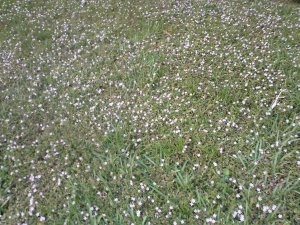My garden tour this Saturday morning revealed a few new things in the garden. I have been shopping online. It seems safe to say not everything that will grow here has been tried here. Famous last words. Spring brings new things to all gardens. To tour more gardens and see what’s springing elsewhere from many different places, follow this link to Jim’s blog and check out the comments.

One new thing is the Chicken Gizzard plant (Iresine herbstii) There are a few mysteries about this plant. First, why is it called Chicken Gizzard? Second, where to plant it? The pundits disagree on whether it will grow outside here and say full sun. Full sun in Ohio (the plant was grown there) is one thing, in South Florida it’s a whole different thing. A dilemma to be solved.

The miniature pineapples are flowering.

An example of how tough bromeliads are. I was clearing some bromeliads, cutting this pup off early this week, left it on top of the bucket, not feeling decisive about where to replant it, then forgot about it. It just kept on growing. This is a silvery purple brom with pink flowers. I may remember the name…

I hope this is a praying mantis and not an evil plague.

A Dracaena reflexa I am pruning to a multi trunk tree. It is at least 10 feet tall.

Mangoes are looking more like mangoes!
That is all from South Florida. Our crazy warm weather continues – it is forecast to be nearly 90F/32C here today. I am heading back out to plant that bromeliad pup before it gets too hot.
Happy Gardening.



















